6th arrondissement of Paris
The 6th arrondissement of Paris (VIe arrondissement) is one of the 20 arrondissements of the capital city of France. In spoken French, it is referred to as le sixième.
6th arrondissement of Paris | |
|---|---|
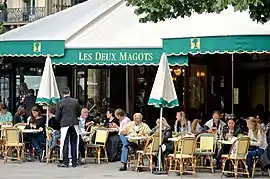 Terrace of café Les Deux Magots, opened in 1885 on Boulevard Saint-Germain | |
 Coat of arms | |
 Location within Paris | |
| Coordinates: 48°51′2″N 2°19′56″E | |
| Country | France |
| Region | Île-de-France |
| Department | Paris |
| Commune | Paris |
| Government | |
| • Mayor (2020–2026) | Jean-Pierre Lecoq (LR) |
| Area | 2.154 km2 (0.832 sq mi) |
| Population | 39,625 |
| • Density | 18,396/km2 (47,650/sq mi) |
| INSEE code | 75106 |
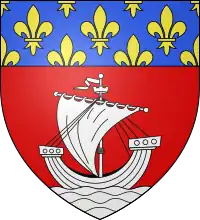 Paris Coat of Arms 20 arrondissements of Paris | |||||||||||||||||||||||||||||||||||||
|---|---|---|---|---|---|---|---|---|---|---|---|---|---|---|---|---|---|---|---|---|---|---|---|---|---|---|---|---|---|---|---|---|---|---|---|---|---|
|
|||||||||||||||||||||||||||||||||||||
The arrondissement, called Luxembourg in a reference to the seat of the Senate and its garden, is situated on the Rive Gauche of the River Seine. It includes educational institutions such as the École nationale supérieure des Beaux-Arts, the École des hautes études en sciences sociales and the Institut de France, as well as Parisian monuments such as the Odéon-Théâtre de l'Europe, the Pont des Arts, which links the 1st and 6th arrondissements over the Seine, Saint-Germain Abbey and Saint-Sulpice Church.
This central arrondissement, which includes the historic districts of Saint-Germain-des-Prés (surrounding the abbey founded in the 6th century) and Luxembourg (surrounding the Palace and its Gardens), has played a major role throughout Parisian history and is well known for its café culture and the revolutionary intellectualism (existentialism, authors such as Jean-Paul Sartre and Simone de Beauvoir) and literature (writers Paul Éluard, Boris Vian, Albert Camus and Françoise Sagan) it has hosted.
With its cityscape, intellectual tradition, history, architecture and central location, the arrondissement has long been home to French intelligentsia. It is a major locale for art galleries and fashion stores,[2] as well as Paris's most expensive area. The arrondissement is one of France's richest districts in terms of average income; it is part of Paris Ouest alongside the 7th, 8th and 16th arrondissements, as well as the Neuilly-sur-Seine inner suburb. The 6th arrondissement is the smallest in Paris in terms of area covered.
History
The current 6th arrondissement, dominated by the Abbey of Saint-Germain-des-Prés—founded in the 6th century—was the heart of the Catholic Church's power in Paris for centuries, hosting many religious institutions.
.jpg.webp)
In 1612, Queen Marie de Médicis bought an estate in the district and commissioned architect Salomon de Brosse to transform it into the outstanding Luxembourg Palace surrounded by extensive royal gardens. The new Luxembourg Palace turned the neighbourhood into a fashionable district for French nobility.
In the aftermath of the French Revolution, architect Jean-François-Thérèse Chalgrin was commissioned to redesign the Luxembourg Palace in 1800 to make it the seat of the newly-established Sénat conservateur. Nowadays, the grounds around the Luxembourg Palace, known as the Senate Garden (Jardin du Sénat), are open to the public; they have become a prised Parisian garden across from the 5th arrondissement's Panthéon.
Since the 1950s, the arrondissement, with its many higher education institutions, cafés (Café de Flore, Les Deux Magots, La Palette, Café Procope) and publishing houses (Gallimard, Julliard, Grasset) has been the home of much of the major post-war intellectual and literary movements and some of most influential in history such as surrealism, existentialism and modern feminism.
Geography
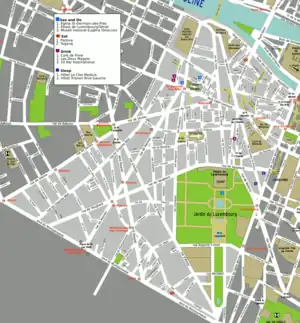
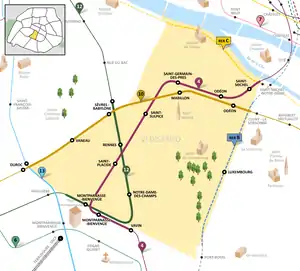
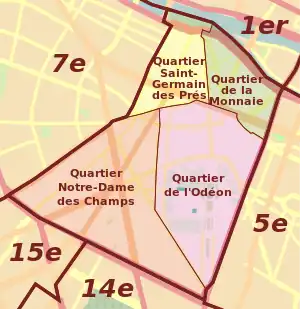
The land area of the arrondissement is 2.154 km2 (0.832 sq. mile, or 532 acres).
Cityscape
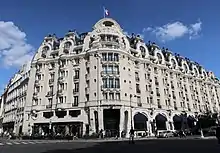
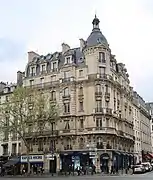 Corner between Boulevard Saint-Germain and Rue Saint-Jacques
Corner between Boulevard Saint-Germain and Rue Saint-Jacques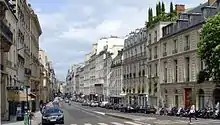 Rue Tournon
Rue Tournon
Places of interest
- Académie Française
- Café de Flore
- Café Procope
- Hôtel de Chimay
- Hôtel Lutetia
- Institut de France
- Jardin du Luxembourg
- Latin Quarter (partial)
- Les Deux Magots
- Medici Fountain
- Notre-Dame-des-Champs, Paris
- Odéon-Théâtre de l'Europe
- Polidor
- Pont des Arts
- Pont Neuf
- Pont Saint-Michel
- Saint-Denys-du-Saint-Sacrement (Neoclassical church)
- Saint-Germain-des-Prés (church)
- Saint-Germain-des-Prés quarter
- Saint-Sulpice church
Museums
Colleges and universities
- Université Paris Cité (Saints-Pères campus)
- Pantheon-Assas University (main campus)
- Catholic University of Paris (main campus)
- Lycée Stanislas
- École des hautes études en sciences sociales
- École nationale des ponts et chaussées
- École nationale supérieure des Beaux-Arts (PSL University)
- École nationale supérieure des mines de Paris (PSL University)
- Lycée Fénelon
- Lycée Montaigne
- Lycée Saint-Louis
Former places
Main streets and squares
- Place du 18-Juin-1940
- Rue de l'Abbaye
- Rue de l'Ancienne Comédie
- Rue André-Mazet
- Rue d'Assas
- Rue Auguste Comte
- Rue de Beaux Arts
- Rue Bonaparte
- named after Napoleon
- Rue Bréa
- named after General Jean Baptiste Fidèle Bréa (1790–1848)
- Rue de Buci
- named after Simon de Buci, President of the Parlement of Paris, who had purchased the Gate Saint-Germain (now demolished) in 1350
- Rue des Canettes
- Rue Cassette
- Rue du Cherche-Midi
- Rue Christine
- named after Christine of France, Duchess of Savoy (1606–1663)
- Rue de Condé
- named after the former Hôtel de Condé, of which forecourt faced the street
- Quai de Conti
- Rue Danton
- Passage Dauphine
- Rue Dauphine
- named after King Louis XIII (1601-1643), Dauphin of France from 1601 to 1610
- Rue du Dragon
- Rue Duguay-Trouin
- Rue Dupin
- Rue de l'École de Médecine
- Rue de Fleurus
- Rue du Four
- Place de Furstemberg
- Rue de Furstemberg
- Rue Garancière
- Quai des Grands-Augustins
- Rue des Grands Augustins
- Rue Grégoire de Tours
- named after Saint Gregory of Tours, Bishop of Tours (538–594)
- Rue Guisarde
- Rue Guynemer
- Rue Hautefeuille
- Place Henri Mondor
- Rue Jacques Callot
- named after Jacques Callot (1592–1635), engraver
- Rue du Jardinet
- Rue Jacob
- Rue Lobineau
- Rue Mabillon
- Rue Madame
- named after Marie Joséphine of Savoy (1753–1810), styled Madame
- Quai Malaquais
- Rue Mayet
- Rue Mazarine
- Rue de Médicis
- Rue de Mézières
- Rue Mignon
- Rue Monsieur-le-Prince
- Boulevard du Montparnasse
- Rue de Nesle
- Rue de Nevers
- Rue Notre-Dame des Champs
- Carrefour de l'Odéon
- Rue de l'Odéon
- Rue Palatine
- named after Anne Henriette of Bavaria, Princess Palatine (1648–1723)
- Rue Pierre Sarrazin
- Rue des Poitevins
- Rue du Pont de Lodi
- named after Bonaparte's victory on May 10, 1796, at the Battle of Lodi
- Rue Princesse
- named after Catherine de Lorraine, Princess de Dombes (1552–1596)
- Rue des Quatre Vents
- Place du Québec
- Boulevard Raspail
- named after François Vincent Raspail (1794–1878) French chemist and politician
- Rue de Rennes
- Rue Saint-André-des-Arts
- Rue Saint-Benoît
- Boulevard Saint-Germain (partial)
- Rue Saint-Jean-Baptiste de la Salle
- Boulevard Saint-Michel (partial)
- Place Saint-Michel (partial)
- Place Saint-Sulpice
- Rue Saint-Sulpice
- Rue des Saints Pères
- Rue de Savoie
- Rue de Seine
- Rue de Sèvres
- Rue Stanislas
- named after the nearby collège Stanislas, founded under Louis XVIII of France, and named after one of his first names
- Rue de Tournon
- named after Cardinal François de Tournon (1489–1562)
- Rue de Vaugirard (partial)
- Rue Vavin
- named after the 19th-century politician Alexis Vavin
- Rue Visconti
- named after Louis Visconti (1791–1853), designer of Napoleon's tomb
Demography
The arrondissement attained its peak population in 1911 when the population density reached nearly 50,000 inhabitants per km2. In 2009, the population was 43,143 inhabitants while the arrondissement provided 43,691 jobs.
Economy
Toei Animation Europe has its head office in the arrondissement. The company, which opened in 2004, serves France, Germany, Italy, Spain, and the United Kingdom.[3]
Real estate
The 6th and 7th arrondissements are the most expensive districts of Paris, the most expensive parts of the 6th arrondissement being Saint-Germain-des-Prés quarter, the riverside districts and the areas nearby the Luxembourg Garden.
Historical population
| Year (of French censuses) |
Population | Density (inh. per km²) |
|---|---|---|
| 1872 | 90,288 | 41,994 |
| 1911 (peak of population) | 102,993 | 47,815 |
| 1954 | 88,200 | 41,023 |
| 1962 | 80,262 | 37,262 |
| 1968 | 70,891 | 32,911 |
| 1975 | 56,331 | 26,152 |
| 1982 | 48,905 | 22,704 |
| 1990 | 47,891 | 22,234 |
| 1999 | 44,919 | 20,854 |
| 2009 | 43,143 | 20,067 |
Immigration
| Born in metropolitan France | Born outside metropolitan France | |||
|---|---|---|---|---|
| 79.6% | 20.4% | |||
| Born in overseas France |
Born in foreign countries with French citizenship at birth1 | EU-15 immigrants2 | Non-EU-15 immigrants | |
| 0.6% | 5.0% | 6.1% | 8.7% | |
| 1 This group is made up largely of former French settlers, such as Pieds-Noirs in Northwest Africa, followed by former colonial citizens who had French citizenship at birth (such as was often the case for the native elite in French colonies), as well as to a lesser extent foreign-born children of French expatriates. A foreign country is understood as a country not part of France in 1999, so a person born for example in 1950 in Algeria, when Algeria was an integral part of France, is nonetheless listed as a person born in a foreign country in French statistics. 2 An immigrant is a person born in a foreign country not having French citizenship at birth. An immigrant may have acquired French citizenship since moving to France, but is still considered an immigrant in French statistics. On the other hand, persons born in France with foreign citizenship (the children of immigrants) are not listed as immigrants. | ||||
Notable people
- Raymond Aron (1905–1983), historian and philosopher
- Maurice Françon (1913–1996), engineer and physicist
References
- "Populations légales 2020". The National Institute of Statistics and Economic Studies. 29 December 2022.
- "Rue de Sèvres. Hermès store. Paris". Paris Digest. 2018. Retrieved 2018-11-21.
- "AFFILIATED COMPANIES Archived 2015-10-19 at the Wayback Machine". Toei Animation. Retrieved on November 17, 2011. "37 rue du Four 75006 Paris France".